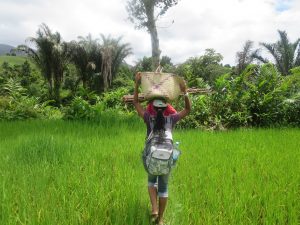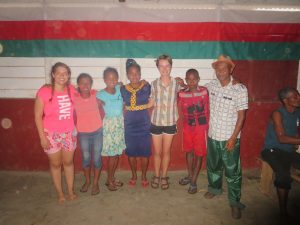As it has been a while since I have posted, here are some brief vignettes from the past few weeks:
Cap Est
While it was all the way back in February, I think it is still worth a mention! Our group got to spend a week at the easternmost point of the island, Cap Est, and study marine biology research methods. The drive to and from the site involved two river crossings in which our taxi brousse was driven onto two large metal canoes with students filing in around. We were powered by two men with long rowing poles, and floated past other boats carrying fleets of motorcycles as a couple of families of cows swam across nearby. The beauty of our campsite on the beach and days in the salt and sun after our journey made for quite the surreal week. Time was spent snorkeling, swimming, talking with local fisher people, climbing lighthouses, and drinking coconuts from the trees.
International Women’s Day
Did you know that March 8 is international women’s day? Neither did I!
To celebrate, our 13 female students collaborated with 13 female students from CURSA, the local university. Malagasy women studying French, English, and the sciences mingled with our American liberal arts and sciences students as we all learned a dance to perform on the holiday. March 8th is a huge celebration in Madagascar, and often involves women dancing and men clapping. The word feminism never really comes up, and the day is more similar to a large party just for women. Our group performed a choreographed ‘rock n roll’ style partner dance, set to the theme song of CURSA. We also participated in a debate between the groups of women on the topic of agriculture in the United States versus Madagascar. The holiday concluded with snacks and soda for everyone, and the connections made between our female students I hope will continue into the future.
Andapa and rural village stay (+ cyclone)
Last week we travelled by bus to what some call the “rice bowl” of Madagascar: the Andapa basin. The shape of the area is often referred to as a cuvette in French, meaning bucket or basin. The students and I were in awe as we drove to the top of our winding road and saw the dramatic (and indeed bucket-shaped) valley of Andapa. Full on the bottom with rice paddies, the city of Andapa, and small villages and surrounded by the green forested mountains of Marojejy and Comatsa, Andapa is truly breath-taking. We staying in a house in the hills, overlooking the whole valley, at avocados, and felt truly charmed.

Juliette carrying a bag of freshly harvested taro through rice paddies (tanimbary) in the Andapa basin
After a few days of visits to protected areas and meetings with the WWF, the students split off into groups with translators, and were adopted for 4 days into the homes of various rural families. With the goal of integrating with rural life as well as conducting participatory social science research on specific themes, we set off into the basin. My theme for the stay was traditional medicinal plants, which I studied with my partner, Samantha. Our family was made up of a father, mother, son and daughter, who warmly welcomed us into their home decorated with hundreds of fake flowers and beautiful fabrics covering the walls. Although rural, many members of the communities we stayed with enjoy the profits from the vanilla industry: the second most widespread crop in the Andapa basin. I felt lucky to enjoy breakfasts of cooked bananas, rice, and condensed milk and dinners of beans, romazava (hot broth of greens), and rice in our host family’s welcoming kitchen. One day, we even got to help grind peanut butter in the large mortar-and-pestel common to the Malagasy countryside (the best peanut butter I have had).

Our final day with rural homestay families, at our farewell party (my host dad in the shiny pants surprisingly whipped out some amazing dance moves)
Unfortunately, our stay in the village was cut short due to the potential threat of a cyclone blowing through the area. Our director made the call to pull us out of our villages one day early and wait out the storm at a hotel in Andapa. The mountains surrounding Andapa protected us from the brunt of the rain and wind, but the southeastern coast suffered damage and mortality. After the storm passed, we returned to a somewhat flooded Antalaha, and reflected on the week’s events.
This week we prepare for our upcoming independent studies. Spoiler: I’m headed north!


Cap EST looks beautiful and the adventures of travel in Madagascar seem noteworthy. Thanks for sharing.
Living in rural Andapa must have been very interesting-would like to hear more.
Glad you were safe from the cyclone 🙏😁